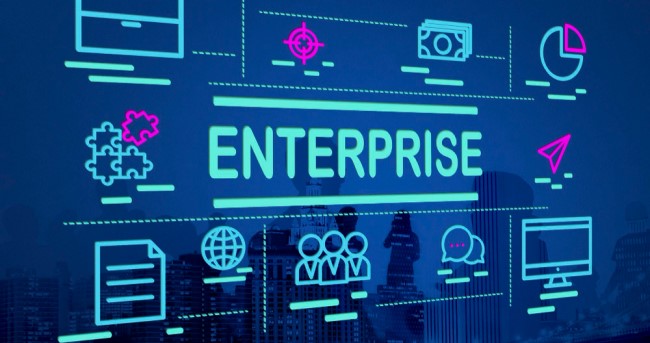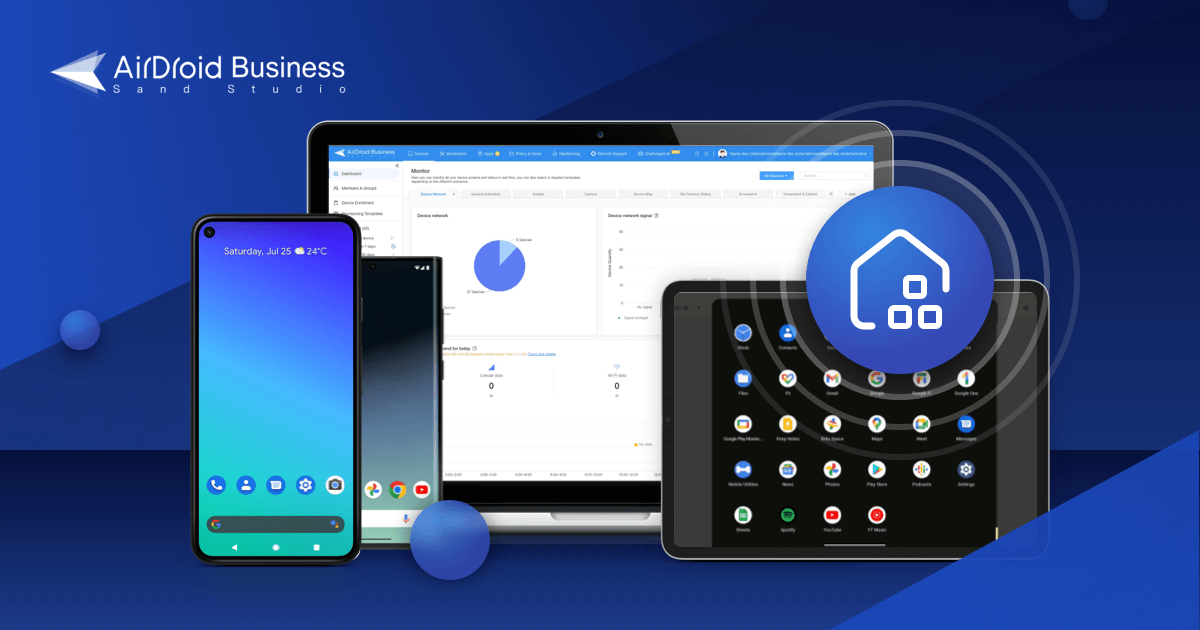What Enterprise IT Management Includes & 9 Best Software
In today's fast-paced business landscape, the triumph of both large companies and nimble startups hinges significantly upon the effectiveness of their enterprise IT management. From sprawling data centers and network infrastructure to the intricate interplay of servers, computers, routers, etc. these technologies collectively form the lifeblood of any corporation.
The vitality of a company's IT infrastructure reverberates across all facets of its operations, influencing everything from internal communication and data storage to customer engagement and strategic decision-making.
In this article, we embark on a journey into the realm of Enterprise IT Management. We will delve deep into its fundamentals, exploring the myriad elements and cutting-edge software tools that stand as pillars of support, promising not only seamless operation but also the prospect of turning your enterprise into a thriving, profit-generating powerhouse.
What Is Enterprise IT Management?
Enterprise IT management is the essential backbone of any organization's digital infrastructure. It involves the meticulous oversight and administration of an organization's IT department, which encompasses networks, hardware, and software.
At its core, enterprise IT management ensures that the IT ecosystem runs seamlessly and swiftly responds to any hiccups along the way.
Monitoring
One of the paramount roles of enterprise IT management is to maintain a vigilant watch over all IT sectors and their various components. When an issue arises, the IT management team springs into action, swiftly diagnosing and implementing solutions to minimize downtime and disruptions. This rapid response capability is pivotal in today's fast-paced business environment.
Data Presentation
Beyond the immediate troubleshooting aspect, IT management plays a pivotal role in the financial health of an organization. It diligently monitors and presents data regarding the profitability and costs of various IT initiatives.
By dissecting this data, IT management can identify precisely which aspects of the organization's IT operations influence its bottom line. This insight empowers decision-makers to optimize their IT investments for maximum returns.
Security
Additionally, the IT department shoulders the responsibility of ensuring the company's web presence and software remain free from bugs and security vulnerabilities.
Preventing data breaches is a paramount concern, and IT administrators continually update and fortify security systems and software to keep threats at bay. In today's digital landscape, where data breaches can be catastrophic, this role is more crucial than ever.
In essence, enterprise IT management delves deep into the inner workings of a company's digital ecosystem. This responsibility typically falls under the purview of the Chief Information Officer (CIO) or equivalent executive leadership within the organization.
Furthermore, it's worth noting that the IT staff or team also plays a significant role in the operation and management of enterprise IT management within a corporation. Their expertise and dedication are integral to the smooth functioning of IT systems and the successful execution of IT strategies.
Infrastructure Component | Managed Resources |
|---|---|
Hardware | Servers, computers, data centers, switches, routers, peripherals (like monitors, keyboards, printers), and other networking equipment |
Software | Operating systems, enterprise applications, databases, middleware, virtualization platforms, development tools |
Network | Network equipment (routers, switches, hubs), network protocols, network services (DNS, DHCP), firewalls, load balancers, IP addresses, network interfaces, VPNs |
Storage | On-site data centers, cloud storage, Network Attached Storage (NAS), Storage Area Networks (SANs), backup systems, disaster recovery systems |
Services | Cloud services (IaaS, PaaS, SaaS), IT consulting services, data processing services, automated systems management services |
Data | All organizational data, including databases, data warehouses, big data systems, business intelligence systems |
Types of Enterprise IT Management Software and Uses
Enterprise IT management tools play a pivotal role in the smooth operation of organizations across various industries. These software tools are essential for ensuring the efficient functioning of an organization's IT department. Now, we will delve into different types of enterprise IT management software and their specific uses.
1IT Asset Management Software
IT asset management software is designed to oversee both hardware and software resources within an organization. It helps manage hardware components such as networking equipment, computers, and servers, as well as software elements like operating systems, application software, and databases.
2Network management and Monitoring Software
Network management and monitoring software are invaluable for identifying and addressing network-related issues. It provides real-time monitoring of network performance, helping organizations quickly identify bottlenecks and troubleshoot problems.
Data Backup and Recovery Software
Data backup and recovery software are crucial for safeguarding critical data. These tools enable organizations to regularly back up data, preventing data loss due to accidents or system failures. In the event of data loss, these tools facilitate swift and reliable data recovery, minimizing downtime.
Cloud Management Software
It allows efficient management of cloud storage, services, and applications, helping organizations optimize their cloud usage and control costs.
Enterprise Resource Planning (ERP) Software
Enterprise Resource Planning (ERP) software is a comprehensive and integrated suite of applications that plays a pivotal role in automating a wide range of business processes. This automation brings about several significant advantages, ultimately enhancing overall efficiency in an organization.
Endpoint Management Software - MDM/EMM/UEM
Endpoint management software is used to oversee and maintain endpoints like computers, laptops, and mobile devices within an organization. It ensures these devices are secure, up-to-date, and compliant with organizational policies.
Project Management Software
Project management software aids in planning, executing, and monitoring IT projects. It offers tools for scheduling tasks, tracking progress, and managing resources efficiently, contributing to successful project outcomes.

9 Best Enterprise IT Management Software
Now, we will explore some of the best Enterprise IT management solutions available in the market. These software options are renowned for their unique features and numerous benefits, making them valuable assets for businesses of all sizes.
- AWS - Best for Cloud Computing Services & Cloud Data Center
- SolarWinds - Best for Network Management & Performance Monitoring
- MySQL - Best for Open-source Database Management
- Microsoft Azure Database - Best for Managed Cloud Database Service
- AirDroid Business - Best for Android Device Management

- Microsoft Intune - Best for Unified Endpoint Management
- Jira by Atlassian - Best for Project Management & Tracking
- IDrive - Best for Cloud Data Backup
- Veeam - Best for Data Protection & Recovery (cloud, virtual & hybrid)
1AWS
Microsoft Azure Database offers a wide range of options, including automatic patching and backup services.
Key Features
- Scalability: AWS boasts unparalleled scalability, catering to the needs of both small businesses and large corporations.
- Reliability: Developed by Amazon, AWS has an unquestionable reputation for reliability.
- Security: Security is paramount in the corporate world, and AWS excels in providing top-tier protection.
- Flexibility: With a vast array of services, AWS offers unmatched flexibility for diverse business needs.
- Cost-effectiveness: Remarkably cost-effective, AWS outshines its competitors without compromising on quality.
2SolarWinds
SolarWinds specializes in asset management solutions for IT departments. It simplifies the management of critical tools such as applications, servers, and networks.
Key Features
- Network Performance Monitoring: Monitoring network performance becomes effortless with SolarWinds.
- Server and Application Monitoring: Keep a close watch on applications and servers for seamless operations.
- Log Management: Efficiently manage logs, a critical aspect of corporate functioning.
- Security and Compliance: SolarWinds ensures top-notch security and compliance standards.
- IT Service Management: Simplify IT service management with this versatile software.
3MySQL
MySQL, an open-source database system, is a versatile choice for developing applications, whether small or large.
Key Features
- High Performance: MySQL delivers unmatched performance for your data needs.
- Scalability: Capable of handling immense loads, it's perfect for building complex, large-scale software.
- Flexibility: Being open-source, MySQL is adaptable for various software applications.
- Reliability: Widely trusted by major corporations and developers, MySQL's reliability is unquestionable.
- User-Friendly: Its user-friendly interface makes database management accessible to all.
4Microsoft Azure Database
Microsoft Azure Database offers a wide range of options, including automatic patching and backup services.
Key Features
- Automatic Patching: Effortlessly update database with automatic patching.
- Backup and Recovery: Ensure data safety and easy recovery with Azure's services.
- High Availability: Enjoy high availability, making it suitable for most corporations.
- Security and Compliance: Microsoft Azure's security measures are top-notch.
- Scalability: Easily handle large-scale applications with automatic patching and backup.
5AirDroid Business - Free for all features in 14 days
AirDroid Business offers a suite of applications for efficient device management, trusted by numerous corporations and industries.
Key Features
- Device Deployment and Provisioning: Set up devices tailored to your company's needs seamlessly.
- Mobile Application Management: Manage mobile applications with ease.
- Security Policy: Robust security measures ensure corporate data protection.
- Remote Control: Easily control various aspects of applications.
- Location Tracking: Monitor device locations remotely, a standout feature of AirDroid Business.
6Microsoft Intune
Microsoft Intune is a reliable UEM solution for corporations, enabling centralized device monitoring and control.
Key Features
- Device Management: Simplify device management across your organization.
- App Management: Easily manage applications within your corporate environment.
- Mobile Application Protection: Enhance security for corporate applications.
- Conditional Access: Control employee access to specific applications.
- PC Management: Manage policies and software for PCs with ease.
7Jira by Atlassian
Jira by Atlassian aids employees in organizations by facilitating task tracking, planning, and management.
Key Features
- Project Management: Streamline the management of tasks, whether single or multiple.
- Issue Tracking: Easily track and report on employee work issues.
- Customizable Dashboard: Create tailored dashboards and workflows for your workforce.
- Release Planning: Plan product or service releases with ease.
- Integration: Seamlessly integrate Jira with other tools to simplify management.
8IDrive
IDrive offers cloud backup services suitable for corporations of all sizes, ensuring data security and accessibility.
Key Features
- Backup Scheduling: Schedule backups at your convenience, ensuring data protection.
- Security: IDrive provides robust encryption and security for backed-up data.
- Collaboration Tools: Facilitate file sharing and collaboration with ease.
- Server Backup: Comprehensive server backup solutions are also available.
- Compliance: IDrive complies with data protection regulations for peace of mind.
9Veeam
Veeam excels in providing data protection solutions for hybrid cloud environments, particularly in virtual settings.
Key Features
- Backup and Recovery: Veeam offers outstanding backup and recovery for cloud workloads and virtual machines.
- Automation: In the event of system disasters, Veeam automates recovery processes.
- Migration: Effortlessly move data between different clouds with Veeam.
- Monitoring: Monitor your cloud environments with ease using Veeam.
- Analytical Tools: Veeam comes equipped with analytical tools for robust data protection.
These Enterprise IT management software solutions offer a wide range of features and benefits to meet the diverse needs of modern businesses. Whether you require cloud services, database management, device control, or project management, there's a software solution tailored to your requirements.
Why Enterprise Should Use Enterprise IT Management Tools
In today's fast-paced business landscape, every enterprise, regardless of its size or industry, stands to benefit immensely from the adoption of Enterprise IT Management Tools.
These powerful software solutions have become indispensable for modern businesses, revolutionizing the way they operate and unlocking a multitude of advantages.
Efficient Operations of the IT sector
Enterprise IT Management Tools streamline and automate routine IT tasks, liberating your workforce to focus on more critical aspects of your business. Imagine a scenario where the monotonous and time-consuming aspects of IT management are taken care of by sophisticated software, leaving your team with ample bandwidth to strategize and drive profitability.
Leading corporations that have harnessed these tools have witnessed remarkable increases in productivity and profitability, as they can redirect their resources toward innovation and growth.
Collaboration on different Team
Collaboration is the cornerstone of success in today's business environment. Enterprise IT Management Software facilitates seamless data sharing and collaboration among different departments within your organization.
With these tools in place, your teams can effortlessly access and share information from various sources, breaking down silos and enabling cross-functional collaboration. This not only saves time but also nurtures a culture of teamwork, allowing your company to channel its efforts into achieving collective goals rather than getting bogged down by data management challenges.
Security
In the pre-enterprise IT Management era, security breaches and data theft were all too common, posing significant threats to businesses. However, with the advent of these software solutions, security concerns have taken a backseat.
Most of these tools employ advanced encryption techniques to safeguard your company's sensitive information, making it exceedingly difficult for malicious actors to compromise your data. This heightened security provides peace of mind and allows your enterprise to operate with confidence in an increasingly digitized world.

IT Management Glossary
In this IT Management Glossary, we'll unravel the complex world of enterprise IT management using simple, easy-to-understand terms. Whether you're an IT novice or a seasoned pro, grasping these foundational concepts is key to navigating the modern IT landscape.
IT Operations Management (ITOM): Think of ITOM as the conductor of the IT orchestra. It's all about keeping applications, networks, and computing systems in harmony, ensuring they perform optimally and meet your business needs.
IT Service Management (ITSM): Picture ITSM as your IT service concierge. Its job is to deliver end-to-end IT services, making sure your users receive the support and solutions they need.
IT Project Management: This is like the blueprint for your IT endeavors. It involves planning, managing, and executing IT projects to achieve your goals efficiently.
IT Asset Management (ITAM): IT assets are like valuable tools in your IT toolkit. ITAM is the process of managing these assets throughout their lifecycle, extending their usefulness, and reducing risks along the way.
IT Risk Management: IT systems are not immune to risks. IT risk management is all about identifying, prioritizing, and assessing these risks and then taking proactive steps to mitigate them.
IT Governance: Imagine IT governance as the guardian of IT resources. Its role is to ensure that IT investments align with your business objectives, maximizing their impact on your organization.

MDM Buyer's Guide
Enroll Android devices in bulk, manage apps, and remotely troubleshoot anytime.





Leave a Reply.